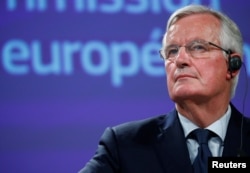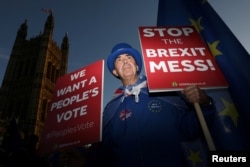British Prime Minister Theresa May scrambled Wednesday to sell to her Cabinet a draft Brexit divorce agreement British negotiators concluded after months of wrangling with their European Union counterparts. After a five-hour Cabinet meeting, Britain’s beleaguered leader got the backing of her ministers.
One-third of the Cabinet spoke out against the deal, however, and the draft agreement had to be approved on a majority vote rather than reached by consensus. Observers expect some ministers to resign in protest in the coming days.
The length of the meeting, which went past its scheduled stop time, is testimony to how the 500-page draft agreement is a source of deep dispute within Britain’s ruling Conservative party and also in the country’s parliament, which will have the final say on whether to approve it.
During a dramatic day with the prime minister coming under sharp attacks from disgruntled Conservative lawmakers, the set choreography for the rollout of the deal was disrupted — with statements and joint appearances in London and Brussels scrapped.
May had been set to make a statement to the House of Commons and she was to have briefed British business leaders. The EU chief negotiator, Michael Barnier, and Britain’s Brexit minister, Dominic Raab, had been scheduled to make a joint appearance in Brussels. All those events were canceled as the Cabinet wrestled over the agreement.
European Union chief Donald Tusk has set Nov. 25 as the date for a summit of leaders so they can endorse a draft Brexit deal.
As news emerged that a text had been agreed to, hardline Brexiteers lined up to attack the proposed agreement with former British Foreign Minister Boris Johnson, who resigned earlier this year, urging other ministers to join him in opposing the terms of the deal. Britain’s main opposition parties also announced their disapproval of the deal, which has not even been published.
The attacks on May from hardline Brexiteers in her party increased during Wednesday. “You are not delivering the Brexit the people voted for,” Conservative lawmaker Peter Bone told her angrily in the House of Commons.
The divorce agreement would see Britain remaining in a customs union for several years with the EU after it formally exits the bloc in March, but with an unclear legal path to quitting the customs arrangement while a fuller trade deal is being negotiated.
Remaining in a customs union allows Britain and the EU to avoid introducing customs checks along the border separating Northern Ireland and the Republic of Ireland and would also allow “frictionless trade” between Britain and its erstwhile partners in the EU.
Tough sell
Critics say it would reduce Britain to the status of a “vassal state” by requiring it to accept EU rules and regulations without having any say about them. It would also block Britain from signing trade deals with other countries while a trade agreement is concluded with the EU, which itself could take three or four years or longer. Reaching trade deals independently with non-EU countries was a key selling point of Brexit for many who voted two years ago in a referendum to relinquish EU membership.
“This is just about as bad as it could possibly be,” Johnson fumed to reporters in the corridors of the British House of Commons. Other Brexiteers joined him to denounce the proposed deal, one they are determined to sabotage and which runs, they say, contrary to the Conservative Party manifesto they fought an election on last year.
“For the first time in a thousand years, this place, this parliament will not have a say over the laws which govern this country. It is quite an incredible state of affairs,” Johnson added.
“She hasn't so much struck a deal as surrendered to Brussels ... the U.K. will be a slave state,” said Conservative lawmaker Jacob Rees-Mogg.
Conservatives’ future at stake
The stakes couldn’t be higher for May. The draft agreement, her fate as prime minister and the longevity of the Conservative government are all hanging in the balance. The consequences of the process to get the draft agreement approved are difficult to guess and could end up sinking May, the Conservative government and even Brexit itself. “I don’t think anyone knows, to be truthful,” said Labor lawmaker Chuka Umunna.
May’s minority government relies on the votes in the House of Commons of a handful of lawmakers from a quirky Protestant-based Unionist party, which also opposes the draft deal.
Without the backing of the Democratic Unionist Party, and faced with an inevitable revolt by several Conservative lawmakers, May will need to persuade opposition lawmakers to break with their party leaderships by arguing her deal is the best Britain can get.
Second vote?
An increasing number of opposition lawmakers are jumping on the bandwagon of the People’s Vote movement, which is calling for a second Brexit referendum. Recent opinion polls suggest a majority of voters now, especially in traditional Labor heartlands, many of whom voted for Brexit, now want Britain to retain EU membership, fearing the economic fallout from departure.
May is scheduled to make a statement to the House of Commons Thursday. May appeared relieved when she came out to reporters in Downing Street after the marathon meeting to announce the Cabinet had agreed to back the deal.
On Tuesday, ahead of Wednesday’s full Cabinet meeting, May took a leaf out of the playbook of her Conservative predecessor Margaret Thatcher, who in 1990 called in ministers one by one to place them on the spot and demand their support. The tactic backfired on Thatcher and she was forced to resign. For May, it apparently worked.
Former Conservative leader Iain Duncan Smith said he believes May’s days will be numbered if she fails to reverse course and decides not to pursue a cleaner break from the EU. Even “if the Cabinet agrees it, the party certainly won’t,” he said.
Leave-supporting ministers had come under intense pressure from hardline Brexiteers in the hours leading up to the meeting to reject the deal. They pointed to a leaked EU document outlining a strategy to force Britain to accept an almost permanent alignment with its rules and regulations governing state aid, environmental protection and workers’ rights.
In a note to EU ambassadors, Sabine Weyand, a deputy EU negotiator, said the customs union will form the basis for Britain’s future trade deal with the bloc. “They must align their rules but the EU will retain all the controls. U.K. wants a lot more from the future relationship, so EU retains leverage,” she wrote.











